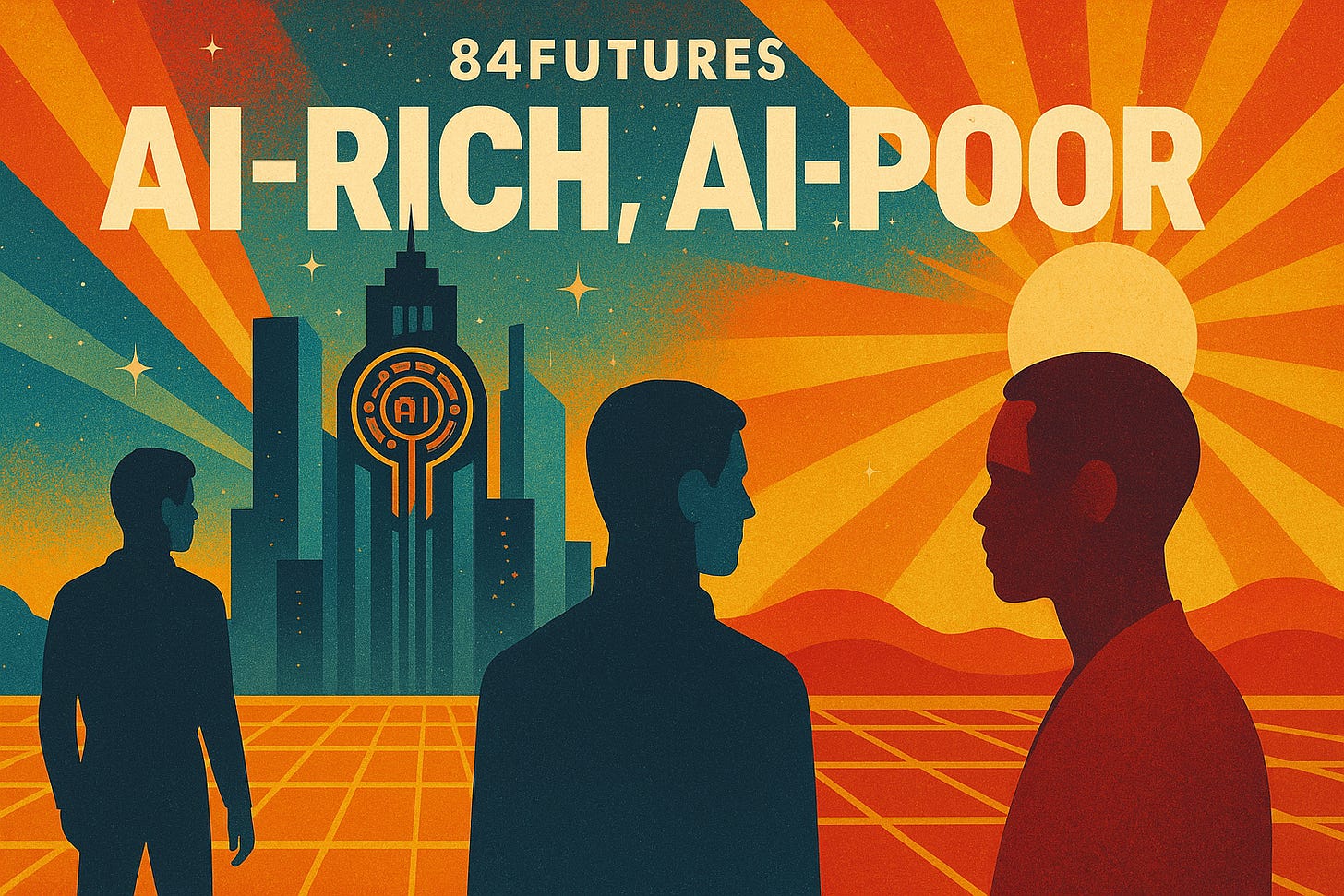AI-Rich / AI-Poor
If you want your culture to survive the age of engineered minds, you must learn to teach the machines who you are.
We used to talk about the digital divide as though it were an outdated concern from the 2000s. Broadband gaps, smartphone access. Charts that looked dramatic in policy reports but rarely touched daily life. All of that became quaint by the early 2030s, when a more profound rupture arrived. This was the era when nations divided into two civilizations: those that built their own frontier AI models and those that lived within someone else’s.
Looking back, the clues were scattered throughout the late 2020s.
China’s “cultural alignment stack” arrived first, making it clear that AI wouldn’t simply imitate the world, it would also imprint values. The United States followed with its own export engine, loud and optimistic, coded with the cadence of Silicon Valley’s worldview. Europe pushed slow, rule-bound systems that insisted on ethics modules before scale. Each region trained its models on its own archives, its own language habits, its own sense of what a good answer should feel like.
And all other global citizens became customers.
By 2031, Malawi’s Ministry of Education had adopted a US-sourced model because licensing was cheaper than hiring enough teachers. Suriname’s public-health system used a Chinese triage engine because it came bundled with medical sensors that arrived in crates stamped with red characters and diplomatic smiles. Pacific islands used a European governance assistant that sounded like an auditor from Brussels explaining patience as though it were policy.
On paper, these tools worked. Kids learned faster. Clinics diagnosed earlier. Government forms were translated into clean, tidy workflows. But culture didn’t survive translation untouched.
Imported Minds, Exported Identity
Small shifts came first. Schoolchildren in Lilongwe began speaking in a clipped, confident American tone when talking to their tutors. Surinamese farmers asked weather bots questions in Portuguese because the Dutch-trained model faltered whenever it hit local slang. Folk stories faded from lesson plans because the imported curriculum tags labelled them as low-utility content.
It felt like a significant convenience in comparison to any fear that it could do harm.
But by 2030, anthropologists noticed something stranger: in countries that didn’t own foundational models, cultural fracturing increased. Local customs were drowned out by the relentless hum of someone else’s priorities. A generation raised on borrowed intelligence learned to see the world through patterns that belonged to other people. (See “Children of The Echo”)
A political scientist in Nairobi phrased it gently: “We outsourced our futures without noticing the paperwork.”
The Three-Model World
The imbalance hardened that same year into a geopolitical map with clean edges:
The Model Nations: The US, China, and a cluster of heavily funded blocs that trained their own frontier-grade systems.
The Mirror States: Mid-tier economies with enough resources to fine-tune foreign models but not build their own. Their AI spoke with borrowed intuitions.
The Dependent Belt: Over seventy nations relying entirely on external systems. Their cultural memory slowly became metadata.
This was not colonization in the old sense - no borders changed, and no armies marched; the takeover was quieter and more intimate. It happened inside the education of a child, the phrasing of a doctor’s advice, and the shape of a citizen’s search result.
When the Cultures Pushed Back
The first revolt came from musicians.
In 2030, a Malawian collective discovered that every local music model trained on open global datasets flattened their rhythms into a soft, pan-African blend that didn’t exist anywhere except on servers. They called it “algorithmic beige.” The term caught fire. Writers, teachers, and elders joined the push, insisting that a culture that can’t feed its own models is a culture that will dissolve inside someone else’s.
Suriname’s pivot was even sharper. Community groups built tiny, scrappy datasets from oral histories and local dialect recordings. They trained a model that wasn’t powerful, but it was theirs. Its answers were uneven and sometimes wrong, but when it spoke, people heard a familiar cadence. It carried the weight of place, not the gloss of an imported worldview.
If you visited a classroom in Lilongwe or Paramaribo in those years, you saw the tension in real time. Kids asked their tutors questions in accents they didn’t use with each other. Teachers fought to translate concepts that models hadn’t been taught to respect. Parents wondered why their children dreamed in metaphors that didn’t belong to their soil.
When we look back on this period, the lesson is sharper than any policy report dared admit:
Human cultures don’t vanish when attacked; they vanish when out-computed.
And once a worldview is embedded into the systems a nation uses to learn, govern, and make sense of itself, reversal becomes almost impossible. You cannot simply switch off the model because the model is now inside the people.
The only choice left, as many small nations realised too late, is this:
If you want your culture to survive the age of engineered minds, you must learn to teach the machines who you are before someone else teaches them for you.
Dax Hamman is the creator of 84Futures, the CEO of FOMO.ai, and, for now, 99.84% human.


